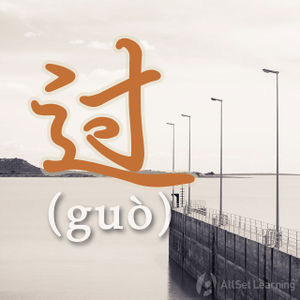Difference between revisions of "Expressing experiences with "guo""
(→Books) |
(→Books) |
||
| Line 55: | Line 55: | ||
* [[Chinese: An Essential Grammar, Second Edition]] (pp. 59-60) [http://www.amazon.com/gp/product/0415372615/ref=as_li_ss_tl?ie=UTF8&tag=allset-20&linkCode=as2&camp=217145&creative=399369&creativeASIN=0415372615 →buy] | * [[Chinese: An Essential Grammar, Second Edition]] (pp. 59-60) [http://www.amazon.com/gp/product/0415372615/ref=as_li_ss_tl?ie=UTF8&tag=allset-20&linkCode=as2&camp=217145&creative=399369&creativeASIN=0415372615 →buy] | ||
* [[Chinese Grammar Without Tears (简明汉语语法学习手册) ]] (pp. 73-4) [http://www.amazon.cn/mn/detailApp/ref=as_li_ss_tl?_encoding=UTF8&tag=allset-23&linkCode=as2&asin=B0041UGAJU&camp=536&creative=3132&creativeASIN=B0041UGAJU →buy] | * [[Chinese Grammar Without Tears (简明汉语语法学习手册) ]] (pp. 73-4) [http://www.amazon.cn/mn/detailApp/ref=as_li_ss_tl?_encoding=UTF8&tag=allset-23&linkCode=as2&asin=B0041UGAJU&camp=536&creative=3132&creativeASIN=B0041UGAJU →buy] | ||
| − | * [[Integrated Chinese: Level 1, Part 2]] (pp. 83- 4) [http://www.amazon.com/gp/product/0887276709/ref%3das_li_ss_tl?ie=UTF8&tag=allset-20&linkCode=as2&camp=217145&creative=399369&creativeASIN=0887276709 →buy] | + | * [[Integrated Chinese: Level 1, Part 2 (3rd ed)]] (pp. 83- 4) [http://www.amazon.com/gp/product/0887276709/ref%3das_li_ss_tl?ie=UTF8&tag=allset-20&linkCode=as2&camp=217145&creative=399369&creativeASIN=0887276709 →buy] |
* [[Integrated Chinese: Level 2, Part 1]] (pp. 345-7) [http://www.amazon.com/gp/product/0887276792/ref%3das_li_ss_tl?ie=UTF8&tag=allset-20&linkCode=as2&camp=217145&creative=399369&creativeASIN=0887276792 →buy] | * [[Integrated Chinese: Level 2, Part 1]] (pp. 345-7) [http://www.amazon.com/gp/product/0887276792/ref%3das_li_ss_tl?ie=UTF8&tag=allset-20&linkCode=as2&camp=217145&creative=399369&creativeASIN=0887276792 →buy] | ||
* [[Integrated Chinese: Level 2, Part 2]] (pp. 49-51) [http://www.amazon.com/gp/product/0887276881/ref=as_li_ss_tl?ie=UTF8&tag=allset-20&linkCode=as2&camp=1789&creative=390957&creativeASIN=0887276881 →buy] | * [[Integrated Chinese: Level 2, Part 2]] (pp. 49-51) [http://www.amazon.com/gp/product/0887276881/ref=as_li_ss_tl?ie=UTF8&tag=allset-20&linkCode=as2&camp=1789&creative=390957&creativeASIN=0887276881 →buy] | ||
Revision as of 09:33, 8 June 2013
-
Level
-
Similar to
-
Used for
-
Keywords
The aspect particle 过 (guo) is used to indicate that an action has been experienced in the past.
Contents
Basic Pattern
Subject + Verb + 过 + Object
What this expresses is that the verb has been done at least once before, without specifying a particular time. 过 is used to talk about whether something has ever happened - whether it has been experienced.
Examples
Some examples of how 过 is typically used:
- 我 去 过 中国。I have been to China.
- 他 吃 过 小笼包。He has eaten steamed dumplings.
- 你 看 过 那 个 人 吗?Have you seen that person?
Negating a 过 sentence
Because 过 is used to talk about past actions, it should be negated with 没. The structure is:
Subject + 没 + Verb + 过 + Object
Some examples:
- 我 没 去 过 中国。I have not been to China.
- 他 没 听 过 这 首 歌。He has not heard this song.
- 你 没 尝 过 这 种 啤酒。You have not tasted this kind of beer.
Using 过 with 了
You'll sometimes see 过 used together with 了. This can be a little confusing, as it doesn't seeing to be following the rules laid out above. For more on this special usage of 过, see the article on using 过 with 了.
Sources and further reading
Books
- A Practical Chinese Grammar For Foreigners (外国人实用汉语语法) (pp. 138) →buy
- Chinese: An Essential Grammar, Second Edition (pp. 59-60) →buy
- Chinese Grammar Without Tears (简明汉语语法学习手册) (pp. 73-4) →buy
- Integrated Chinese: Level 1, Part 2 (3rd ed) (pp. 83- 4) →buy
- Integrated Chinese: Level 2, Part 1 (pp. 345-7) →buy
- Integrated Chinese: Level 2, Part 2 (pp. 49-51) →buy
- Modern Mandarin Chinese Grammar: A Practical Guide (pp. 76-7, 230-2) →buy
- New Practical Chinese Reader 2 (新实用汉语课本2) (pp. 175-6) →buy
Websites
- ChinesePod: Qing Wen - 过(guo) (free podcast content)



